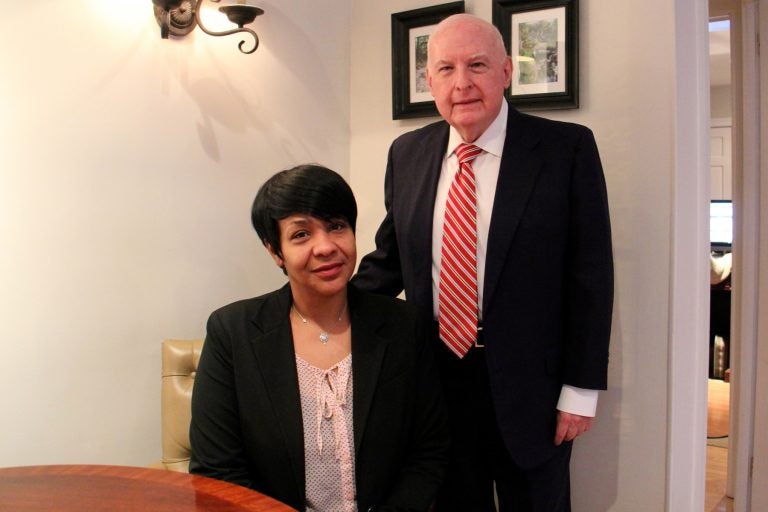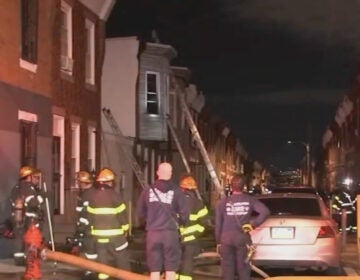Connecting the ‘dots’ with individual stories of lives lost to Philly violence
Philadelphia Obituary Project aims to tell the stories of murder victims by honoring all the good in their lives.
Listen 5:17
Trina Singleton was devastated when her 24-year-old son, Darryl, was shot to death. The Philadelphia Obituary Project, founded by attorney Cletus Lyman, gave her a way to celebrate her son's life and manage her grief. (Emma Lee/WHYY)
Trina Singleton picked up the paper the day after her son was murdered in Southwest Philadelphia. “Violent day in Philly: 10 people shot, three of them fatally,” said the headline.
Based on initial information from police, the article omitted the fact that one of those three was Singleton’s 24-year-old son, Darryl.
He was skinny and had a trim goatee, she said. He wore Malcolm X-style glasses. At the time of his death, he was in school studying to be an EMT and baby-sitting for extra money on the side.
“Darryl was very friendly. He had a lot of personality. He liked helping people,” said his mother.
“He didn’t have a criminal background,” continued Singleton, 46, a real estate agent, who now lives in Delaware County. “He wasn’t a troublemaker.”
But the life of Darryl, the eldest of her three children, was summarized in just one paragraph on Sept. 14, 2016, the day after he was shot to death. The article described the Tuesday he died as “a day of mayhem.”
Philadelphia lawyer Cletus Lyman wants the murder statistics that contribute to street mayhem transformed into real stories. He has launched a nonprofit website called Philadelphia Obituary Project.
“I remember having discussions occasionally when I’d meet journalists. I’d complain about this problem. ‘Why didn’t you follow up on this?’ And I guess it’s a problem of space,” said Lyman, 72, a civil lawyer based in Center City. “And they’d say, ‘Yes, we just don’t have time to do this.’”
Lyman’s originally from Hazleton, a small town in northeastern Pennsylvania. There, he said, everyone got an obituary, whether you were a baker, bus driver or a CEO.
The same is not true in a city as vast and violent as Philadelphia, where the hundreds murdered every year often turn into mere data points.
“They might give you a map with little dots on it, and that’s all that these people were as far as information you could get publicly,” Lyman said. “They were dots on a map.”
Turning a single dot into a full-bodied story was therapeutic for Trina Singleton.
“It does help the family with the healing and grieving process,” she said. “We are able to reflect on the good parts of that person. And not just what happened to them.”
In the months since her son died, Singleton’s family is still grasping for answers about her son’s violent end.
“When we cleaned his room out, we looked all over the place, because I’m saying, ‘Was he into something that we didn’t know about?’ And there was nothing,” she said. “There was nothing different than what a normal kid would have there.”
’Every single victim is a person’
So far, the project has completed dozens of profiles by freelance reporters. Albert Stumm oversees the Obituary Project stories. A former Philadelphia Daily News editor, he is now a Barcelona-based writer.
“Every single victim is a person, and every single person had hopes and dreams. They had people who loved them,” he said. “They had something in their lives that made them special, and those are the things that we’re trying to focus on.”
The project’s stories are different than a traditional newspaper obituary, which may highlight both the positive and the unfavorable details in a person’s background.
Instead, the Obituary Project allows the surviving family to decide what part of a victim’s past is included, Stumm said.
“What we’re doing,” he said, “is an addendum to the news cycle.”
Stumm said many families feel like their loved one is being blamed for being killed when articles emphasize the circumstances that led to the death. The project, Stumm said, has a different aim.
“Not to be saying, ‘Hey, well, sounds like a nice guy, but what did he do to get himself in that position?’ ”
Right now, Lyman, the lawyer, is personally financing the project, but he said the group will soon launch a fundraising campaign. If they want to chronicle every murder victim in the city, which sometimes means several people in one day, it will take resources beyond just a few part-time journalists.
‘People shouldn’t be relegated to a stat’
At the Philadelphia Police Department headquarters, Commissioner Richard Ross said he hopes the Obituary Project wakes people up to the human toll of the city’s high homicide rate.
Last year, 317 people were murdered in Philadelphia, the highest rate in five years.
“We all have got a role to play in stemming the tide of this violence,” Ross said.
Convincing witnesses to cooperate with authorities is one of the biggest obstacles in making arrests in murder cases.
(Sixteen months after Darryl Singleton’s death, police have still not made any arrests in connection with the case. Police are offering $20,000 for information leading to an arrest and conviction.)
Maybe, Ross said, putting faces to the numbers will encourage more people to step forward to help solve open homicide cases.
“These people shouldn’t be relegated to a stat or a statistic,” Ross said. “At the end of the day, you’re talking about people regardless of what may have happened that caused their demise, and it’s all unfortunate.”
Though participating in the Obituary Project was part of Singleton’s healing process, details of the day of her son’s death will never leave her.
She said he had come to her Collingdale home to do laundry and finished some homework. He mentioned that he would not be going to his EMT class that night, since he said the instructor had canceled. So he went back to his place in Southwest Philadelphia instead.
An hour and a half later, her other son called her husband with the awful news.
When the call came in, her husband was out shopping for a gift for Darryl. The two shared a birthday.
“It’s really sad,” Singleton said. “We had plans for the next day. It was hard. It was hard the way we found out.”
Still trying to come to grips with her loss, Singleton said the project has given her a new sense of community, bringing her closer to other families who have lost loved ones to murder.
It is not a community she ever expected to join.
“We didn’t want our children to turn out like some others that we had seen,” Singleton said, sobbing. “So we tried hard, and for it to happen any way is kind of like, well, you try to do the right thing, and then it happens anyway.”
WHYY is your source for fact-based, in-depth journalism and information. As a nonprofit organization, we rely on financial support from readers like you. Please give today.




